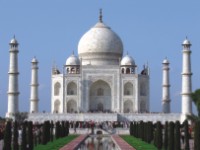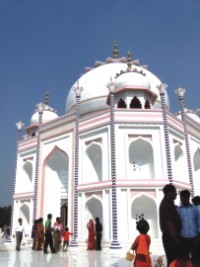|
Reflections
All that Glitters
Syed Zain Al-mahmood
 |
A poor replica: The ‘Banglar Taj Mahal’. |
What would you do if you had $58 million and a 5-acre plot of land to play with? Build a school? A hospital? A factory? How about creating your own copy of one of the Seven Wonders of the World?
We can't go to the Taj Mahal, so the Taj Mahal must come to us -- seems to be filmmaker and hotelier Ahsanullah Moni's rationale for building a replica of the 17th century Mughal monument in his backyard. The replica Taj, built near Sonargaon, Naryanganj, was opened to the public last December with a great deal of fanfare. Speaking to the media, Ahsanullah Moni said he had built the structure to give Bangladeshis a feel of Emperor Shah Jahan's immortal creation. “Everyone dreams about seeing the Taj Mahal but very few Bangladeshis can make the trip because it's too expensive for them,” said Moni. “Shah Jahan built the Taj for the love of his wife. I built my Taj for the love of Shah Jahan.”
It is doubtful whether Shah Jahan would have approved of the way the “Banglar Taj Mahal” was hastily unveiled just before Eid. Scaffolding still surrounded the domes, workmen were polishing the floors and there were holes in the ground where the garden was meant to be - but Ahsanullah Moni’s Taj Mahal was open for business. Critics said the site had been opened prematurely to take advantage of the holiday crowd. “I paid Tk. 50 per head and there was basically nothing to see,” fumed Sadia Chowdhury, who had travelled to Sonargaon with her family for a glimpse of the Taj. “It isn't even finished yet. It's a scam!”
The unusual story attracted widespread attention, and the media faithfully if sardonically reported all of Ahsanullah Moni's statements, including the claims that he had worked with a budget of nearly Taka four hundred crore. Moni said he had imported marble and granite from Italy, diamonds from Belgium and used 160 kilogrammes of bronze for the dome.
The Dhaka-based film industry, popularly and often derisively called Dhaliwood, is infamous for copying foreign movies. So it does not seem strange that a Dhaliwood producer would want to recreate Shah Jahan's timeless monument. But does the Bangla Taj Mahal measure up to the original?
Two months on, the scaffolding is gone. But the “Bangla Taj” still has a decidedly amateurish look. The structure has been billed as a life-size replica, built to scale by architects and engineers who had travelled to Agra many times to take measurements. But that myth is exploded as soon as one sets sight on the model. The replica is around one third the size of the original, and the proportions are also incorrect. Moni's architects failed to reproduce the slender grace of the minarets and the regal majesty of the central dome. The pink linings give the building a cheap look.
 |
The Taj Mahal in Agra. |
Masroor, a Pakistani national working for Warid Telecom, had come with his wife and two young children to see the replica Taj, and admitted he was disappointed. “From a local perspective, it may not be so bad,” he said. “It gives people a place to come and hang out. But from an artistic and aesthetic standpoint, it's not at all impressive. I have seen the real thing, and this doesn't even come close.”
The Taj Mahal in Agra has been described as the most beautiful building in the world. Rabindranath called it “a teardrop on the cheek of eternity.” A powerful symbol of love, and an unparalleled feat of architecture, thousands flock to the World Heritage site every month. Ahsanullah Moni hoped his Taj Mahal would help boost tourism in Bangladesh, but this claim has been ridiculed by observers.
“Why would any tourist want to come to Bangladesh to see a replica when they can see the real article next door?” asked Tahsina, a student of architecture at Shahjalal University of Science & Technology.
However, the site's proximity to Dhaka coupled with the media hype means the faux Taj continues to get many local visitors. A lot of them seem happy to have seen the building. “I can't afford to go to Agra,” said Mohammed Selim, a car salesman. “At least I now know what it looks like.”
But others are less gracious. “I am very disappointed,” said Asaf ud Dawla who works as a merchandiser for a garments company in Narayangonj. “Where are all the expensive materials we heard about? It seems mostly tiles and cement. I had a dream of seeing the grand Taj Mahal. I don't think this merits a second visit.”
Md. Ashraful Haque, a director of Diganta Television was there with his wife. Ashraf thinks the facilities are inadequate. “At least it's a new place to visit. But the narrow village roads aren't really suitable for so many vehicles. The parking arrangements are also not good and there are basically no gardens or grounds to speak of. That's why everyone is sitting in the courtyard.”
Local sources say a tug of war is going on between Ahsanullah Moni's henchmen and village locals. Moni's people are trying to buy up land adjoining the replica Mahal site in order to expand. But his neighbours don't want to sell. They want to cash in on the influx of tourists as the site becomes more popular. “We want to keep our land,” said Arjosh Mia, a local villager. “We might want to build shops or even picnic spots. Now we hear Mr. Moni will use his links with the government to acquire the land.”
 |
Visitors to the ‘Banglar Taj’ were disappointed by the amateurish design and lack of facilities. |
The Taj Mahal has inspired many copies over the centuries. There is a famous one in Aurangabad in India called “Bibi Ka Maqbara” built by Emperor Aurangzeb's son Azam Shah to honour his mother Rabia. But none of the replicas claimed to rival the original. When the “Bangla Taj” story first broke, media reports gave the impression the copycat Taj was somehow a state sponsored gimmick. “Bangladesh Gets Its Own Taj Mahal” was the headline of the AFP story. “Taj Mahal Replica Sparks Diplomatic Row” screamed the Telegraph. Announcement of the opening of the fake Taj Mahal initially drew a sharp reaction from the Indian government, with some high commission officials talking about suing Ahsanullah Moni for infringement of copyright. Bangladeshi observers, however, said there was no law that covered historical monuments and since Bangladesh used to be part of Mughal India, the Taj Mahal is just as much a part of our heritage as theirs.
Copyright issues aside, there are also ethical questions involved. In a country where a large proportion of the population lives below the poverty line, spending $58 million on a copycat monument seems a cruel paradox. Observers suggest Moni could have used the money to build industrial plants that would have created many jobs. And if he had wanted to make a contribution towards preserving our heritage, he could easily have done so -- considering the fact that many of our historical sites are decaying due to lack of care. Sonargaon, the 16th century capital of Isa Khan, lies only a few miles from Moni's Taj Mahal.
“It might be a good idea to create a large heritage park with replicas of other World Heritage sites,” suggested architect Afsar Uddin. “Maybe include the Qutb Minar, Red Fort, Eiffel Tower etc. If the reproduction is accurate, this could be a good draw for local tourists, and be educational for students.”
Even if Ahsanullah Moni was driven by admiration for Emperor Shah Jahan and his immortal love story, he could have used his resources in a more creative way. Legend has it that Shah Jahan planned to build an exact likeness of the Taj Mahal on the opposite bank of the river Jamuna -- out of black marble. The “Black Taj” was to have been Shah Jahan's final resting place. Moni could have built a Taj Mahal out of black stone to help fulfil the Emperor's dream.
There are many who feel film producer Ahsanullah Moni missed the opportunity to create something authentic. “If you want to build a truly iconic tourist destination, why not create something original?” asked Asif, a student of Dhaka University. “At least, that would not make 'Made in Bangladesh' seem like a joke.”
Despite the hype, “Moni's Taj” fails to rise above mediocrity. Emperor Shah Jahan can rest in peace. There will only be one teardrop on the cheek of eternity.
.Copyright
(R) thedailystar.net 2009 |
